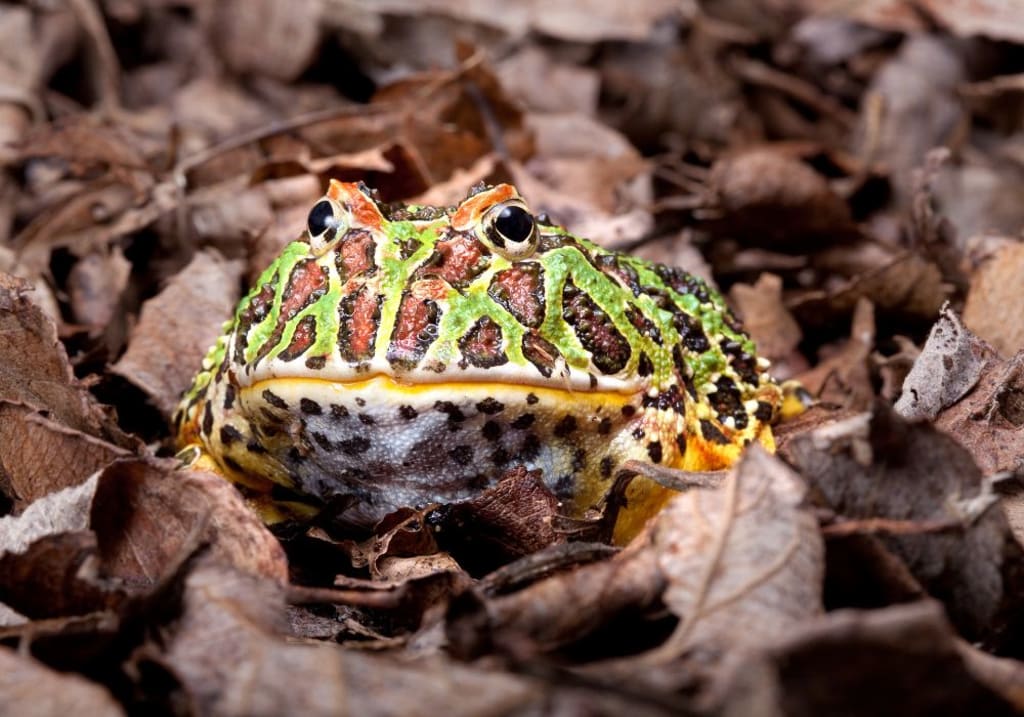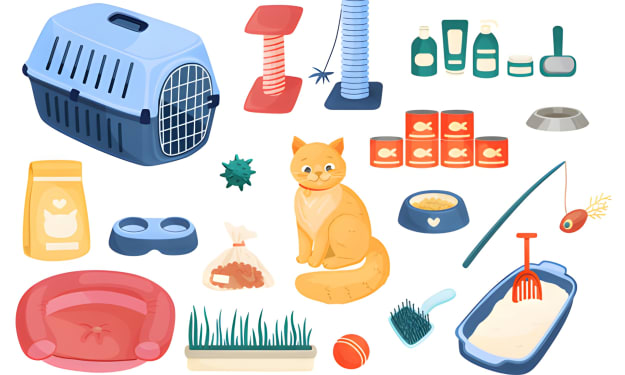The ABCs of Pacman Frog Feeding
What You Need to Know

Introduction to Pacman Frogs and their Feeding Habits
Pacman frogs, also known as ornate horned frogs or Argentine horned frogs, are a type of amphibian. Native to Central and South America, these attractive and often large frogs have become popular pets in recent years due to their unique appearance and friendly personalities. It is important for anyone considering caring for a pacman frog to understand the dietary needs of these fascinating creatures. This article will cover Tips for feeding pacman frogs so that you can ensure your pet enjoys a healthy and balanced diet.
Feeding Habits
Pacman frogs are carnivores. In the wild, they primarily feed on insects such as crickets, grasshoppers, moths, flies, and mealworms. It is important to provide your pet with an appropriate blend of insect prey items as their regular diet. A good rule of thumb is to provide insects that are no bigger than half the size of the frog’s head.
Important Nutrients
Insects should be purchased from a reliable source that has been properly raised in captivity. It is important to dust the prey items with calcium supplements before feeding them to your pacman frog in order to ensure they get all essential nutrients such as calcium and Vitamin D3.
Frequency of Feeding
Younger pacman frogs should be fed every two days while adult pacman frogs should be fed a few times per week depending on how much food they consume in one sitting. Do not overfeed your pet as this could lead to health problems.
Hiding Food
Pacman frogs have an instinctual tendency to hunt for their food rather than accept hand-feeding. To ensure your pet remains engaged during mealtime, you can hide the food items around its enclosure or add floating plants which can provide additional hiding places for prey items.
Conclusion
Feeding pacman frogs requires an understanding of their natural eating habits as well as knowledge of the essential nutrients they require for optimal health. With the right tips for feeding pacman frogs, you can provide your pet with a nutritious diet that will help keep them fit and happy!
Types of Food Pacman Frogs Can Eat
When it comes to feeding pacman frogs, there are many different types of food they can eat. It is important to understand what they need to be healthy and happy. Tips for feeding pacman frogs include offering a variety of foods, such as live insects, fruits and vegetables, and commercial pellets.
Live Insects
Live insects are a great source of protein for pacman frogs. Common choices include crickets, waxworms, earthworms, mealworms, and fruit flies. Make sure the insects you feed your frog are appropriately sized; crickets should be smaller than the space between their eyes. Be sure to dust their food lightly with calcium powder or a vitamin/mineral mix before giving them to your frog.
Fruits & Vegetables
Fruits and vegetables provide important vitamins and minerals that pacman frogs need for a balanced diet. Some ideal choices include apples, bananas, green beans, squash, collard greens, pears, and oranges. To provide more nutrition for your frog you can steam or puree these foods before offering them so they will be easier to digest.
Commercial Pellets
In addition to live insects and fresh fruits and veggies you can also offer your pacman frog commercial pellets that have been specifically designed for amphibians. Many of these pellets contain essential vitamins and minerals which help keep your frog healthy. However it’s important to note that any type of pellet should only make up part of their diet; the bulk should come from live insects and fresh produce.
When it comes to tips for feeding pacman frogs there is much more than just offering a variety of foods. It is also important to make sure their habitat is clean at all times so they don’t get sick from unsanitary conditions or contaminated food sources. Additionally providing a shallow bowl filled with water will help your frog stay hydrated as well as allowing them the opportunity for swimming if desired. With proper care and feeding habits your pet pacman frog will stay happy and healthy!
Frequency and Amount of Feeding for Pacman Frogs
Tips for feeding pacman frogs is an important factor to consider when raising these unique little amphibians. Pacman frogs are known as voracious eaters with big appetites, but it is important to be mindful of how often and how much you feed your pet frog. Overfeeding can lead to health problems, so knowing the correct frequency and amount of food for your frog is essential. Pacman frogs should typically be fed every other day, but some frogs may require a different schedule depending on their age and activity level. Juvenile pacman frogs tend to need more frequent meals, while larger adult pacman frogs require fewer meals due to their slower metabolism.
It is also important to consider activity level; active pet frogs may need more food than less active ones. The size of the meal you provide should be based on the size of your frog; feeding too large a portion can lead to digestive issues or obesity. An easy rule of thumb is that the meal should be no bigger than the size of your pet's head. You can also use prey items such as crickets, earthworms or other insects as a guide; avoid offering prey that are longer than twice the length of your frog's body. Lastly, it is important to provide variety in terms of both nutrition and texture in order to keep your pet well-fed and healthy.
Offer a mix of live insects such as crickets, worms, and waxworms; high quality dry foods specifically formulated for amphibians; and occasional treats such as cooked ground turkey or boiled egg whites. In conclusion, ensuring your pacman frog receives appropriate nutrition requires careful consideration when it comes to frequency and amount of feeding. Knowing what type of food to offer at what time is key in keeping your pet healthy and happy!
Nutritional Requirements for Pacman Frogs
Pacman frogs, also known as horned frogs, are exotic amphibians that require special feeding requirements to stay healthy. Knowing a few basic tips about how to feed pacman frogs can ensure they live a long and happy life. It is important to understand the dietary needs of these frogs to provide them with the nutrition they need.
Foods Rich in Animal Proteins
Pacman frogs rely heavily on animal proteins for their diet. Live or frozen insects such as crickets, mealworms, waxworms and earthworms should be fed 2-3 times a week. Feeding your frog too frequently can lead to health problems such as obesity and liver disease; therefore, it is important to monitor the amount and frequency of their meals. To supplement their protein intake, feed them an occasional pinky mouse or appropriately sized feeder fish.
Calcium Rich Foods
In addition to high protein foods, calcified insects like cuttlebone and calcium-dusted crickets should be given 1-2 times per week to keep your pet's bones strong and healthy. A dusting of commercially available vitamin supplements can help provide all the necessary nutrients your frog needs if they are not getting enough dietary calcium from their regular food source.
Fruits & Vegetables
Pacman frogs should also have access to fruits and vegetables in addition to animal proteins and calcium sources. Fruits like apples, blueberries and strawberries can be offered peeled in small pieces once a week. When it comes to vegetables, try boiled sweet potato or carrot cubes for a nutritious treat once or twice per month.
Feeding them any other type of fruit or vegetable may lead to digestive issues so it's best to stick with the ones mentioned above unless otherwise specified by your veterinarian. Overall, feeding pacman frogs is not difficult but knowing what type of food they need is essential in order for them thrive! Proper nutrition helps maintain good health while providing adequate amounts of proteins helps support growth and development. Lastly, dusting their food with vitamins ensures that they are getting all the necessary nutrients required for a healthy life.
Tips for Safely Handling and Feeding Pacman Frogs
Pacman frogs are a unique addition to any home, and while feeding them is an exciting prospect, it's important to approach this activity with caution. As with any pet, proper handling and feeding can make all the difference when it comes to your frog's health. To help you get started, here are The ABCs of Pacman Frog Feeding: What You Need to Know.
A - Appropriate Food
It is important that you feed your Pacman Frog only food that is appropriate for their diet. Live food such as crickets, worms and earthworms are the best options as they provide natural prey items that mimic what would be found in the wild. It is also important to source your food from reliable vendors as this will ensure quality nutrition without the risk of parasites or impurities. In addition, if you’re using live food, it’s important to only feed them what they can eat within a five-minute time frame - anything beyond that should be removed from the enclosure as soon as possible.
B - Cleanliness
Cleanliness is paramount when taking care of a Pacman Frog - both for its own health and your own safety. Make sure you wash your hands thoroughly before handling the frog or its food in order to prevent contamination from outside sources like bacteria or parasites. Additionally, clean up any excess food that your frog may have left behind in its enclosure within 24 hours to prevent build-up of dangerous bacteria, mold or fungus.
C - Calcium & Vitamins
Just like with other animals, nutrition plays an important role in keeping a Pacman Frog healthy and happy. All live foods should be dusted with calcium powder and vitamins prior to feeding every 2 weeks; otherwise they could suffer from deficiencies over time which may lead to metabolic bone disease or other conditions. Finally, always provide a shallow dish of fresh water inside their enclosure – don’t let it become stagnant by not changing it out every 2-3 days at least!
Overall, proper care and feeding of a Pacman Frog should not be taken lightly; however care must be taken so as not compromise its health or yours! It’s important to ensure all live foods are properly dusted with calcium powder and vitamins before being fed on a regular basis; also making sure enclosures are kept clean through frequent cleaning/water changes will further help maintain the health of your pet. With these tips in mind you can rest assured that both you and your frog will remain safe and happy!
About the Creator
Hasan
Welcome...
In this site of mine you can learn amazing things and many information that you don't know so please subscribe to my site.
Enjoyed the story? Support the Creator.
Subscribe for free to receive all their stories in your feed. You could also pledge your support or give them a one-off tip, letting them know you appreciate their work.






Comments
There are no comments for this story
Be the first to respond and start the conversation.